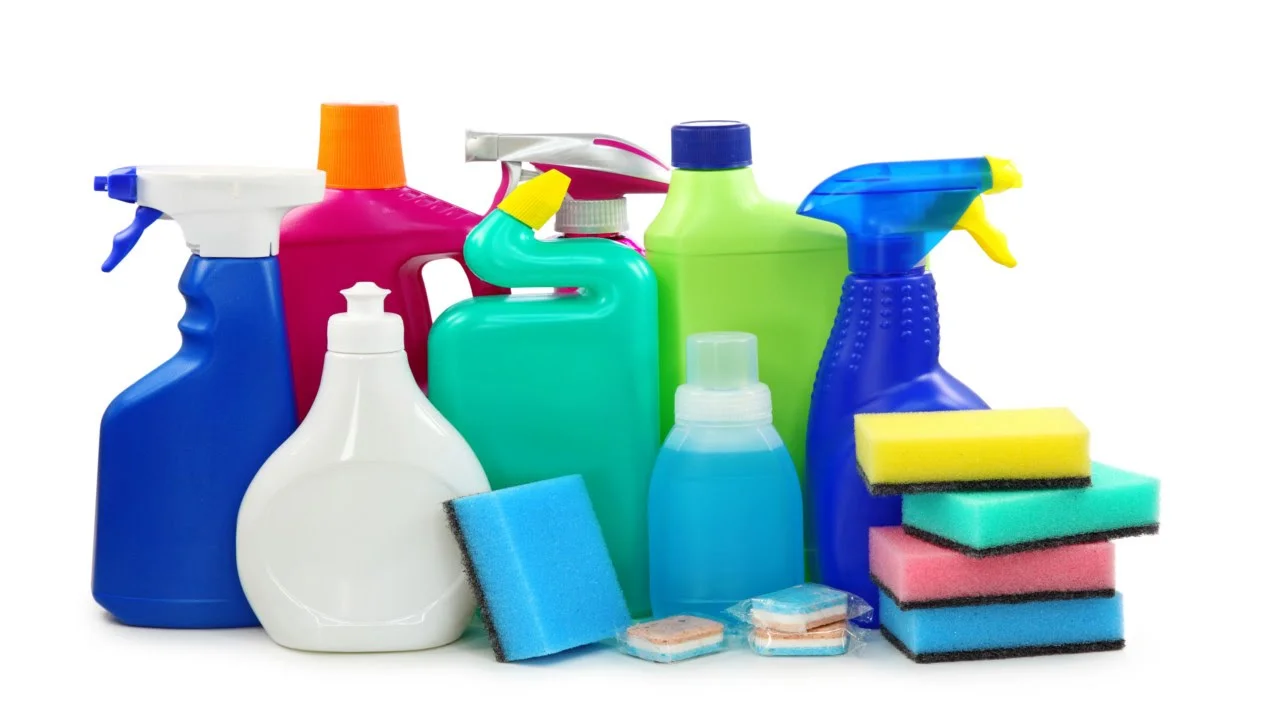My Top 4 Steps to Detoxing Your Home And Improving Your Hormones and Fertility
We are exposed to so many chemicals every day, coming from our environment, food, and the things we use on or near our bodies. What you may not realize is that all of these chemicals can be wreaking major havoc on your hormones and fertility.
These chemicals are hormone disruptors which not only mimic some of our bodies natural hormones (and not in a good way!), but can also throw our delicate hormonal balance way off.
Some of these chemicals in our environment we cannot control, but there are sooo many things we can control. What we eat, what we use in our households, what we put on our bodies, and what we use to clean - these are all areas within our control where we can detoxify our bodies and make powerful positive changes to our hormones and fertility.
Ready?
Let’s get to it!
Opt Out Of Using Plastics
This includes most plastics (even those that may be labeled as BPA-free) in forms such as food containers, canned foods, water bottles, and food wrap. These BPA and non-BPA plastics can be incredibly detrimental to our hormones, fertility, and overall health. They have been shown to interfere with the activity of estrogen, testosterone, and thyroid hormones.
Not only do you need to be concerned over these plastics in general, but additionally it’s been found that when exposing these plastics to any type of heat - whether through washing with hot water, microwaving, or leaving out in the sun (like a water bottle in your hot car) - a further increase in disruptive hormone activity is seen.
Several studies in 2011 & 2012 on the effects of BPA in women undergoing IVF found that those with higher BPA exposure had eggs which were less likely to fertilize, fewer eggs were retrieved, lower estrogen levels, and increased rates of implantation failure (those with the highest levels of BPA had twice the instances of implantation failure as opposed to those women with the lowest levels of BPA).
Many of the studies to date on plastics and hormones/fertility have been on BPA, or bisphenol A. However, we are now finding out that non-BPA plastics may also pose a big problem to hormones and fertility and that it’s best to avoid all plastics as much as possible.
These BPA and non-BPA plastics are also a big contributing factor as to why so many more women are experiencing estrogen excess symptoms such as weight gain (especially in the hips, thighs, and abdomen), fatigue, irregular cycles, uterine fibroids, PMS, low libido, etc. Plastics contain xenoestrogens, chemical compounds which mimic estrogen. Continued exposure of xenoestrogens leading to estrogen dominance in the body can also lead to things such as hormonal cancers, autoimmune conditions, thyroid conditions.
Action steps: 1. Never heat plastic in a microwave. 2. Switch out all plastic in your kitchen - this includes storage containers, bowls, cups - and replace with glass, stainless steel, ceramic, and wood. 3. Buy BPA free canned goods. Eden foods is a company which has BPA free canned food. Most of the Trader Joe’s private label canned goods are also BPA free, although they are not labeled as such - refer to their website for a comprehensive list. 4. Avoid handling paper receipts and opt for electronic receipts when available - most contain BPA.
2. Tidy Up Your Household Cleaning Supplies
This section includes taking a look our daily household cleaning household use supplies which many times contain incredibly toxic chemicals, known to disrupt our hormones, fertility, and overall health.
Many household products contain pthalates, which are toxic chemicals found in supplies containing synthetic fragrances - like air fresheners, perfumes, dish or hand soaps, and toilet paper. They are known endocrine disruptors and have been shown to significantly affect sperm quality in men and egg development in women. They are recognized as a reproductive toxin by the European Union and also acknowledged as an endocrine disruptor more recently in 2012 by the FDA.
Also, check your carpet spot removers and carpet/upholstery cleaners for toxins. These contain a chemical called Perc or perchlorate. Perc is a neurotoxin and possible carcinogen. It is also found in dry cleaning products.
Other items to switch out are your window, bathroom, and multipurpose cleaners. Many times these contain a toxic chemical called 2-butoxyehtanol.
Your bathroom scouring cleaning supplies and toilet bowl cleaners also may contain chlorine, another toxic chemical found to disrupt thyroid and respiratory function.
For more information, the Environmental Working Group has a great guide to healthy cleaning at www.ewg.org/guides/cleaners. You can also look up your current household cleaning supplies here to see if and how many toxins they may contain. You may be surprised that even some of the advertised “green” products actually aren’t so green. However, a little vinegar, baking soda, and essential oils go a very long way to create healthy cleaning options for your home.
Action steps: 1. As you start to run out of certain cleaning supplies you are using, begin looking up each one on the environmental working group’s website and if they are toxic, look to replace with a healthier option that you can either make on your own or buy (www.thrivemarket.com has some safer options at good prices). Or, focus on one cleaning supply item each week to replace with a healthier option - this way the task won’t seem so overwhelming. 2. Get rid of the fake scents in your home - perfumes, air fresheners, scented candles, toilet paper, etc. 3. Find green alternatives to dry cleaning your clothes by using a Green Dry Cleaner or hand wash, steam, etc.
3. Clean Up Your Household Bath And Body Supplies
Another place to look for lurking toxins contributing to reproductive and other health issues are inside your bath and body products.
According to the Environmental Working Group, the average person uses about 10-15 personal care products daily with 126 different ingredients daily. And, according to Amy Meyers, M.D. “An average of seven new industrial chemicals get approval by the US government daily, and eighty percent of these are approved in three weeks or less with little or no safety testing done. Many of these industrial chemicals are the basic ingredients in our cosmetics and personal care products.”
Nail polish, as an example, contains a high amount of pthalates, toulene, and formaldehyde. Formaldyde and toulene have been linked to increased risk of miscarriage and reduced fertility.
Parabens are also found in many hair and body products and have been found to be hormone disruptors, creating an effect of estrogen dominance.
Here is a list of some of the products you may be currently using which you may want to find less toxic versions of: makeup, body or face lotions, skin care products, sunscreen, shampoo/conditioner, other hair products like hairspray, soaps, feminine hygiene products, toothpaste, nail polish/remover, deodorant, and hair dye.
You can also look up the products you currently use by product name on the Environmental Working Group’s Skin Deep website at www.ewg.org/skindeep to check what rating your products have. The smaller the number, the better - strive for products which are mostly rated as 1’s.
The main list of toxic bath and body ingredients to avoid in the products you buy are the 12 ingredients listed below.
Parabens
Phthalates
Sodium laurel sulfate
PEG compounds like propylene glycol
DEA
Formaldehyde-releasing preservatives
Triclosan
Butylated hydroxytoluene (BHT)
Siloxanes
Coal tar dyes
Petrolatum
Fragrance or parfum
Some additional suggestions for keeping a healthy body and home environment are:
Always take off your shoes inside your home.
Have lots of plants throughout your home.
Open windows to get circulation and fresh air.
Vacuum (with a HEPA filter) frequently (or buy one of those little robotic vacuums, one of the best purchases of my adult life!).
Look in to a carbon whole house or counter top water filter and/or a reverse osmosis water filter.
Consider HEPA air purifiers in certain rooms that you spend the most time in.
Purchase a flame retardant free mattresses and furniture.
Buy pillows and sheets/bedding made with organic and natural ingredients.
4. Eat Organic And Non-GMO Foods As Much As You Can
By choosing organic, you can reduce your exposure to pesticides, herbicides, fungicides, and dietary hormones. Opt for only organic meat and dairy products and with buying organic as much as you are able to in your other food products as well.
For fruit and vegetables, the Environmental Working Group comes out with a yearly Dirty Dozen and Clean 15 list which helps you decide on which foods to always buy organic vs. which you may be able to get away with buying conventional because the pesticide levels were low.
Pesticides in our food can definitely have an effect on our hormones and fertility. For example, men whose diets contain more pesticides are 10 times more likely to have a lower sperm count. On the flip side, men who eat mostly organic produce have higher sperm counts and greater quality vs. men eating conventional pesticide-laden produce. In addition, a 2018 study in the Journal of the American Medical Association (JAMA) found that women with the highest pesticide exposure had the lowest pregnancy rates.
The good news, though, is that once you switch to eating organic foods, your body’s level of toxins can dramatically reduce pretty quickly. In a recent small study on kids who had autism or a seizure disorder, they found that after 6 weeks on an organic diet the levels of glyphosate (the main toxic herbicide used worldwide today) were reduced by 94.2% and their symptoms improved. Yet another recent small study in adults and children found a reduction in urinary metabolites of insecticides, fungicides, and herbicides when they switched to an organic diet. So, even if you haven’t been eating organic up until now, there is evidence that your toxin levels can greatly reduce with the switch to organic.
To Sum It Up
These suggestions will keep you busy in the beginning, but the payoff in the reduction of your body’s toxic load will be immense once you work on swapping your current products for healthier versions. Your hormones, fertility, and overall health will be positively affected by taking away some of these big contributors to toxins in your body. We can’t live in a bubble and are always going to be exposed to some toxins throughout our daily lives. But that is okay, because our bodies are built for dealing with toxins to a certain extent. It’s only when our toxic burden becomes too high in relation to how our body can neutralize and get rid of the toxins that things become more of an issue. So it’s up to us to reduce the toxins we can control and let our bodies to the rest.
Are you a woman trying to get pregnant and looking for more personalized guidance and support into natural ways to increase your fertility? Book a FREE Fertility Audit call with a member of our team here.
~~~~~~
References
Directive 2005/84/EC of the European Parliament and of the Council of 14 December 2005.
US. Dept of Health and Human Services, Food and Drug Administration, Center of rDrug Evaluation and Research (CDER), Guidance for Industry: Limiting the Use of Certain Pthalates as exciptients in CDER-Regulated Products, December 2012.
Hunt PA, Koehler KE, Susiarjo M, Hodges CA, Ilagan A, Voigt RC, Thomas S, Thomas BF, Hassold TJ. Bisphenol a exposure causes meiotic aneuploidy in the female mouse. Curr Biol. 2003 Apr 1;13(7):546-553.
https://jamanetwork.com/journals/jamainternalmedicine/article-abstract/2659557
Hyland C, Bradman A, Gerona R, Patton S, Zakharevich I, Gunier RB, Klein K. Organic diet intervention significantly reduces urinary pesticide levels in U.S. children and adults. Environ Res. 2019 Jan 29.

